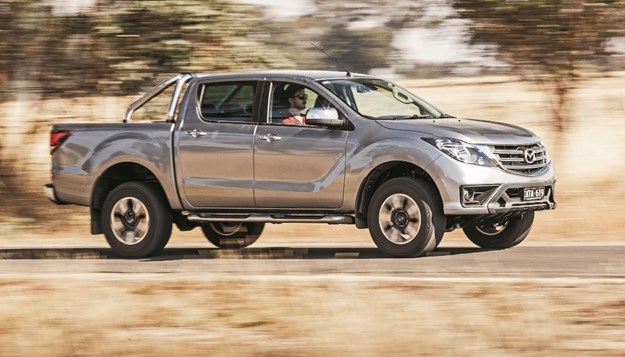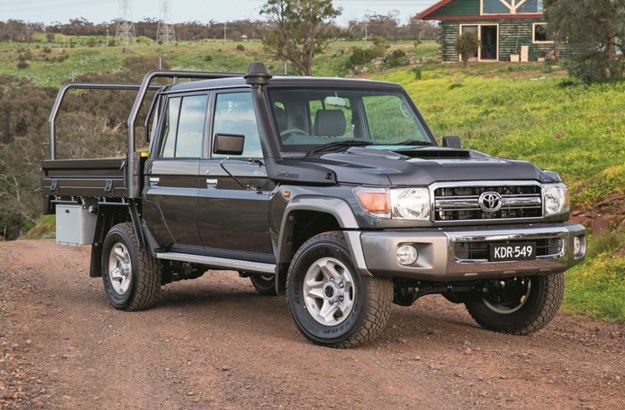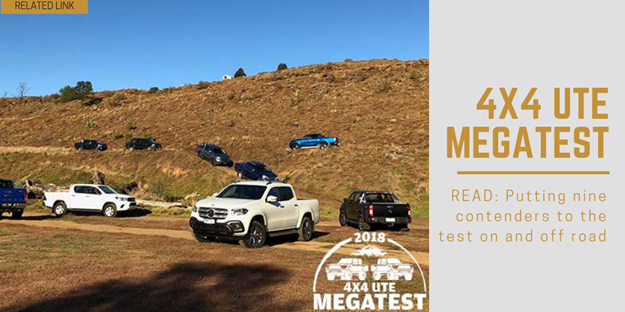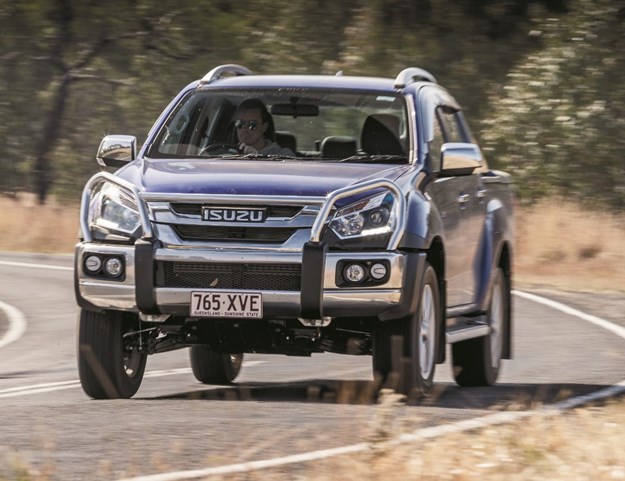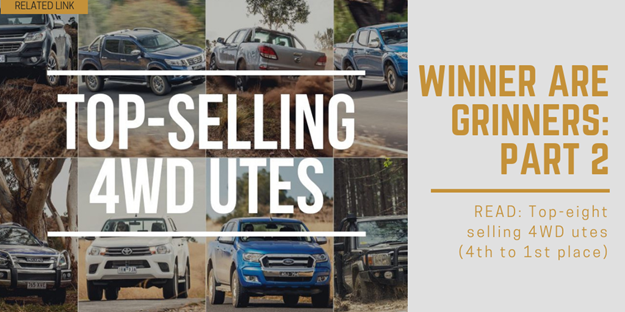Australians love utes – especially 4WD utes – like never before. Here’s the first part of a rundown on the eight best-selling 4WD utes for the first half of the year
Year-on-year sales of new 4WD utes continues to boom thanks largely to some 5,900 new units being sold in the first half of 2018 compared with the first six months of 2017. That represents a healthy 7.1 per cent increase.
Some 80 to 90 per cent of utes sold are dual cabs, which reflects the repositioning of utes away from being purely work vehicles.
Against this background of stronger sales, not all of the most popular utes are selling better than they did this time last year…
8: Mazda BT-50
The Mazda BT-50 shares the Ford Ranger’s parentage but not its success
Mazda’s BT-50 is the third vehicle in the best-selling 4WD utes to suffer a sales decline in the first six months of 2018 compared with the same time last year. Mind you it’s only dropped by 1.3 per cent year-on-year but due to better sales of others the BT-50 now only scrapes into the top eight by around 150 units in front of the steadily-improving Volkswagen’s Amarok.
In what has been a booming ute market over the past decade, the BT-50s sales have remained pretty constant since it first arrived in late 2011. In its first full year of sales in 2012, 8,279 BT-50 4WDs were sold while last year 8,900 BT-50 4WDs were sold.
It’s hard to believe how poorly the Mazda BT-50 sells in comparison to the Ford Ranger given they are – in essence – the same ute. Over four Rangers are currently sold for every one Mazda BT-50 and while the Ranger offers some notable technical advantages adopted for the 2016 model year, the BT-50 is generally cheaper.
In Mazda’s defence the company is probably more concerned with its small passenger cars and SUVs, which are its big sellers, where for Ford the Ranger is the main game. In overall new-car sales, Mazda is also well ahead of Ford.
In most ways the BT-50 drives much like the Ranger. For starters its 3.2-litre five-cylinder engine retains the same torquey, low-revving, smooth running and agreeable character even if it’s not as quiet or as responsive as the Ranger’s. The BT-50 also doesn’t have the Ranger’s electric power steering, which makes for the Ranger’s easier low-speed manoeuvring, although others will argue that the Mazda’s ‘old-school’ hydraulic system is potentially more robust.
Off road the BT-50 is a good thing although a notch down from the Ranger due to another 2016-model upgrade the Ford received – leaving the front traction control active when the rear locker is engaged – which Mazda did not adopt.
Otherwise everything that is likable about the Ranger, including a spacious cabin and excellent towing and load-carrying ability, is essentially true of the BT-50.
Sales
2018 sales (to June 30th): 4,683
2017 sales (to June 30th): 4,746
Change: Down 1.3%
Report Card
Engine and gearbox: C
Handing and ride: B
Cabin and equipment: B
Load and tow: B
Off-road: B
Comment: Essentially a Ford Ranger wearing another badge but not as good in the detail.
Specs: Mazda BT-50 XTR
Engine: 3.2-litre 5-cyl turbo diesel
Max Power/Torque: 147kW (197hp)/470Nm
Gearbox: Six-speed automatic
4X4 System: Dual-range part-time
Kerb Weight: 2,118kg
GVM: 3,200kg
Towing capacity: 3,500kg
GCM: 6,000kg
Fuel tank capacity: 80 litres
ADR fuel claim: 9.2 litres/100km
READ: Mazda BT-50 – 2018 4×4 Ute Megatest
7: Toyota LandCruiser 79 Series
It’s the oldest and most expensive vehicle amongst the best-selling 4WD utes but its year-on-year sales increase is the strongest
The LandCruiser 79 Series, complete with its then all-new 4.5-litre V8 diesel, arrived in 2007 and has never been more popular than it is now. In fact, in the first six months of 2018 it has sold almost as well as it did for the full 12 months of 2008. What’s more surprising is that its year-on-year sales increase to June 30 is better than any of the other best-selling utes with a 24 per cent increase, despite the fact that it’s the oldest and most expensive ute here.
In its 11-year history in Australia, two significant things have happened to the LC79. Firstly, in late 2012 the dual-cab model appeared, Australia being the first market to receive it off the back of what Toyota said was “demand from the booming mining sector and others”.
Then in late 2016, the 79 received a raft of updates, many of which came from meeting mandatory government safety and emission standards as well as industry safety demands.
First up all models gained electronic stability control (and electronic traction control as a side benefit). Then to meet Euro 5 emission standards all models gained a diesel particulate filter and piezo injectors.
All variants also got locking hubs, cruise control and a new five-speed gearbox with a much-needed taller top gear as well as a taller second gear. To meet industry occupational health and safety demands for a five-star ANCAP safety rating, the single-cab model also gained curtain and driver’s knee airbags and thicker frame rails.
As ever the 79 is very truck-like to drive compared with others utes you’ll find amongst these best sellers and doesn’t offer much in the way of on-road civility in terms of handling, ride or noise refinement.
All that is, however, forgiven when the 79 is asked to work hard carrying or towing a big load, or off road, where it is near unstoppable. And the further you get from civilisation, the more the 79 makes sense. And if you do happen to be in the absolute middle of no-where it’s the only 4WD ute you really want.
Sales
2018 sales (to June 30th): 5,140
2017 sales: (to June 30th): 4,142
Change: Up 24.1%
Report Card
Engine and gearbox: C
Handling and ride: D
Cabin and equipment: C
Load and tow: A
Off-road: A
Comment: The 79 is the yardstick in toughness and go anywhere ability.
Specs: Toyota LandCruiser 79 dual-cab
Engine: 4.5-litre V8 turbo diesel
Max Power/Torque: 151kW (202hp)/430Nm
Gearbox: Five-speed manual
4X4 System: Dual-range part-time
Kerb Weight: 2,175kg
GVM: 3,300kg
Towing capacity: 3,500kg
GCM: 6,800kg
Fuel tank capacity: 130 litres
ADR fuel claim: 10.7 litres/100km
BUY: Toyota Landcruisers for sale
6: Isuzu D-Max
The D-Max remains the number-six best-selling 4WD ute but it’s gaining ground on the Navara
Some 6,409 D-Max 4WDs were sold in the first six months of 2108, a 6.4 per cent increase on the same period last year. That’s not sufficient to see it climb out of the number-six spot in the year-to-date best sellers but at the same time it’s not far behind the Navara in sales and could pip it by year’s end.
Since the arrival of this generation D-Max in 2012 it has enjoyed a steady increase in sales. In its first full year in 2013, some 8,488 D-Max 4x4s were sold. Last year 12,795 D-Max 4x4s found new homes. That’s a 50 per cent increase over that four-year period and sales continue to trend in the right direction so far this year.
The D-Max sold now is, however, a different vehicle from the D-Max that arrived here in 2013 mainly thanks to a raft of upgrades for the 2017 model initiated by mandatory compliance to Euro 5 emissions standards that came into effect in December 2016. This bought a diesel particulate filter but at the same time Isuzu reworked the engine’s top-end (from the pistons up), new turbo and all, to bump the maximum torque from 380Nm to 430Nm for better drivability, and to quieten down what’s always been a relatively noisy engine.
At the same time an Aisin six-speed automatic, similar to what’s used in the Hilux and Prado, replaced the previous five-speed auto and a six-speed manual replaced the previous five-speeder.
For the 2018 model, Isuzu has made changes to the cabin, equipment levels, and rear suspension. SX, LS-U and LS-T dual-cab 4WDs now have softer three-leaf springs instead of the five-leaf springs used previously. The end result is a more compliant ride when unladen but seemingly diminished ability to carry maximum payloads, if our recent 4×4 Ute Megatest is anything to go by.
As ever, the D-Max is solid rather than spectacular and while it’s not the last word in what it does on or off the road, it makes a lot of sense as an ownership proposition.
Sales
2018 sales (to June 30th): 6,409
2017 sales (to June 30th): 6,127
Change: Up 4.6%
Report Card
Engine and gearbox: C
Handing and ride: C
Cabin and equipment: C
Load and tow: C
Off-road: D
Comment: The D-Max is solid in every regard without being spectacular in any way.
Specs: Isuzu D-Max LS-U
Engine: 3.0-litre 4-cyl turbo diesel
Max Power/Torque: 130kW (174hp)/430Nm
Gearbox: Six-speed automatic
4X4 System: Dual-range part-time
Kerb Weight: 1,945kg
GVM: 2,950kg
Towing capacity: 3,500kg
GCM: 5,950kg
Fuel tank capacity: 76 litres
ADR fuel claim: 7.9 litres/100km
READ: Isuzu D-Max – 2018 4×4 Ute Megatest
5: Nissan Navara
Recent changes to the Navara D23 haven’t helped it gain any more traction in the market place
The Navara is the second of the best-selling 4WD utes to actually lose sales in the first half of 2018 compared with the same time last year despite a rising market.
In the first six months of 2018 Nissan sold 6,722 Navara 4WDs, some 651 fewer than the same time in 2017. This may not look like a big drop but comes despite two upgrades since this generation Navara (the D23) first appeared in late 2015 and in light of generally disappointing sales along the way. When you considered the previous D40 Navara was selling twice that back five years ago – in a 4WD ute market that was 20 per cent smaller – and was second only to the all-conquering Hilux at the time, the D23 hasn’t been what Nissan would have wanted.
The D23 (or NP300 as it was initially known) came with the fanfare of coil-spring rear suspension, a theoretically better arrangement than leaf springs, and a sophisticated bi-turbo engine and accompanying seven-speed automatic gearbox.
While the engine provided plenty of performance, helped by the seven-speed auto and relatively short gearing, the coil-spring rear suspension, especially for heavy load carrying or towing, was problematic right from start. The front-to-rear suspension match wasn’t great either, nor was the too-heavy and too-slow steering.
Within 12 months Nissan addressed this via the Series II model with new rear coils, new dampers front and rear and revised suspension bushings. More suspension changes were implemented for the 2018 model with a second new set of rear coils, new rear dampers and a revised steering rack.
Thankfully, the Navara is better for all these changes, especially in its general on-road handing, ride and steering, which is now very acceptable in fact. But it’s still not great at towing its claimed 3,500kg maximum tow weight or carrying its full theoretical payload of around 1,000kg. Nor is it a gun off-road ute where its lack wheel travel and low-ish stance puts it at a disadvantage compared to the best of its rivals.
Sales
2018 sales (to June 30th): 6,722
2017 sales (to June 30th): 7,373
Change: Down 8.8%
Report Card
Engine and gearbox: B
Handling and ride: C
Cabin and equipment: C
Load and tow: D
Off-road: D
Comment: Second revision of the Navara’s coil-spring rear suspension makes for better, but still not great, load and tow performance.
Specs: Nissan Navara ST
Engine: 2.3-litre 4-cyl bi-turbo diesel
Max Power/Torque: 140kW (188hp)/450Nm
Gearbox: Seven-speed automatic
4X4 System: Dual-range part-time
Kerb Weight: 1,865kg
GVM: 2,910kg
Towing capacity: 3,500kg
GCM: 5,910kg
Fuel tank capacity: 80 litres
ADR fuel claim: 7.0 litres/100km
READ: Nissan Navara – 2018 4×4 Ute Megatest



